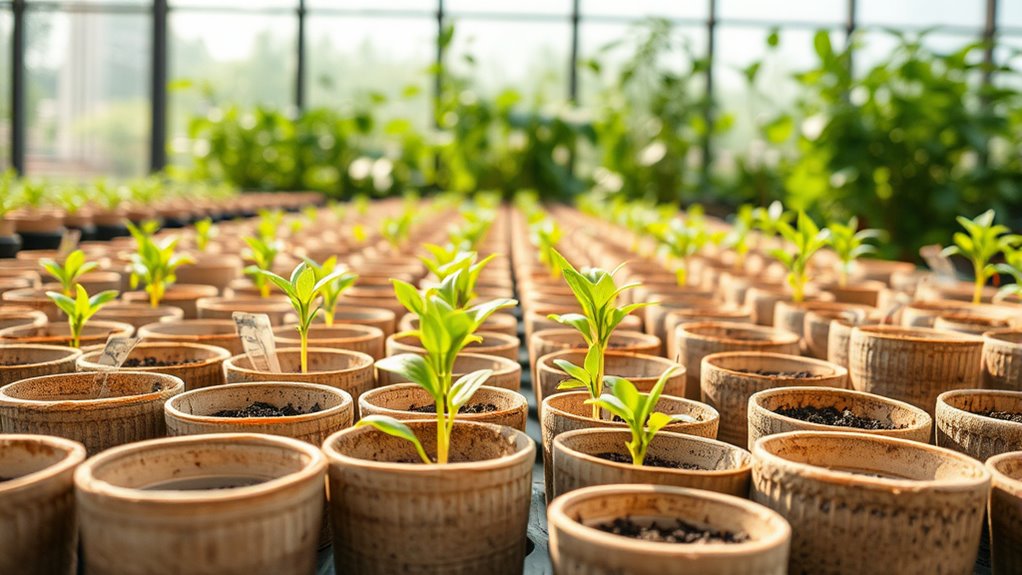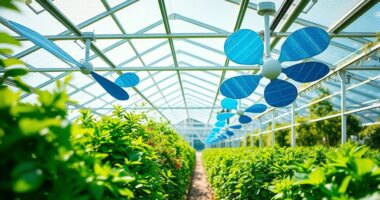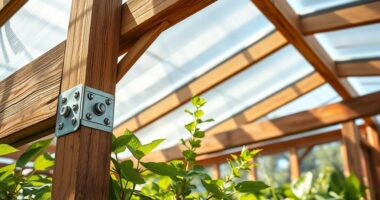Biodegradable plant pots and trays are excellent eco-friendly options for your greenhouse. Made from renewable materials like cornstarch, rice husks, or coconut coir, they break down naturally, enriching your soil and reducing plastic waste. These lightweight containers support healthy root growth and can be planted directly into the ground or composted after use. By choosing biodegradable options, you’re helping the environment and promoting sustainable gardening practices — discover how these solutions can benefit your greenhouse system.
Key Takeaways
- Made from renewable, biodegradable materials like cornstarch and rice husks, reducing environmental impact.
- Facilitate direct planting and soil enrichment, promoting healthy root growth and reducing transplant shock.
- Lightweight, durable trays organize seedlings efficiently and can be composted after use.
- Support sustainable gardening practices by minimizing plastic waste and encouraging composting.
- Contribute to eco-friendly greenhouse operations, lowering pollution and promoting greener gardening solutions.

Biodegradable plant pots are an eco-friendly alternative to traditional plastic containers, helping you reduce waste and protect the environment. When you choose biodegradable options, you’re opting for sustainable materials that break down naturally over time, leaving no harmful residue behind. These materials often include substances like cornstarch, rice husks, coconut coir, or other plant-based fibers, which are renewable and have minimal environmental impact. By using sustainable materials, you contribute to reducing the reliance on fossil fuels and lessen the pollution associated with plastic production. This shift not only benefits the planet but also aligns with eco-conscious gardening practices, ensuring your greenhouse remains a space of sustainability.
Biodegradable plant pots break down naturally, reducing waste and supporting eco-friendly gardening practices.
One of the significant advantages of biodegradable plant pots is their composting benefits. When you incorporate these pots into your gardening routine, they can decompose alongside organic waste, enriching your soil with valuable nutrients. You can plant directly into these pots, and as they break down, they nourish your plants instead of becoming waste. Composting biodegradable pots reduces the need for disposal and landfill space, making your gardening activities more sustainable. Additionally, because they decompose quickly—typically within a few months—they free you from the hassle of removing plastic containers or transferring seedlings to different pots.
Using biodegradable plant pots also simplifies your planting process. As your seedlings grow, you can plant them directly into the soil, with the pots degrading naturally without disturbing the roots. This minimizes transplant shock and encourages healthy root development. Plus, their lightweight nature makes handling and transporting plants easier, especially within a greenhouse setting where space and efficiency matter. These pots are compatible with various composting systems, allowing you to close the loop in your gardening cycle and produce less waste. Incorporating sustainable materials can further enhance the eco-friendliness of your gardening practices.
Moreover, biodegradable plant trays complement these benefits by providing a sturdy, eco-friendly platform for your pots. They help organize your seedlings neatly and can also be composted once they’re no longer needed. Overall, by choosing biodegradable plant pots and trays, you’re making a conscious decision to promote sustainable gardening practices, reduce plastic waste, and support the health of your greenhouse environment. This approach ensures your gardening efforts are not only productive but also environmentally responsible, contributing to a greener, more sustainable future.
Frequently Asked Questions
Are Biodegradable Pots Suitable for All Plant Types?
Biodegradable pots are generally suitable for most plant types, but you should consider plant compatibility and pot durability. Some delicate plants may need more sturdy containers, while others thrive in biodegradable options that break down naturally. Keep in mind that these pots might not last as long as traditional ones, so for long-term plants, choose biodegradable pots that offer enough support and durability for healthy growth.
How Long Do Biodegradable Pots Typically Take to Decompose?
Imagine you’re composting plant pots in your backyard. Typically, biodegradable pots take about 3 to 6 months to decompose fully, depending on soil health and composting methods. In rich, aerated compost, they break down faster, enriching soil naturally. If you use cold composting, it might take longer. Proper moisture, temperature, and microbial activity are key for efficient decomposition, helping your garden thrive sustainably.
Can Biodegradable Plant Pots Be Reused or Recycled After Use?
You can often reuse biodegradable plant pots for multiple planting cycles, but recycling procedures typically aren’t necessary since they’re designed to decompose naturally. After use, you might compost them or incorporate them into your garden soil, following proper reuse practices. If you prefer recycling, check local guidelines, but most biodegradable pots are best suited for composting or natural breakdown, reducing waste and supporting sustainable gardening.
Do Biodegradable Pots Require Special Handling or Storage?
Sure, biodegradable pots don’t exactly demand a secret storage vault. You just need to follow simple handling precautions—keep them dry and away from direct sunlight to prevent premature breakdown. Storage requirements are minimal, but it’s wise to store them in a cool, dry place. No special treatment needed, just common sense! So, while they’re eco-friendly, treat them with care, and they’ll serve you well until their end.
Are Biodegradable Plant Trays More Cost-Effective Than Plastic Alternatives?
Yes, biodegradable plant trays are often more cost-effective than plastic alternatives when you consider the overall cost comparison. While they may have a higher initial price, their environmental impact benefits and potential for reducing waste disposal costs make them a smarter choice. Over time, you’ll save money and help the environment, making biodegradable trays a sustainable investment for your greenhouse operations.
Conclusion
Choosing biodegradable plant pots and trays is like planting seeds for a greener future. They break down naturally, nourishing the earth instead of choking it with plastic waste. By making this simple switch, you’re not just nurturing your plants—you’re cultivating a healthier planet. Embrace these eco-friendly options and watch your greenhouse bloom with life and sustainability. Every pot you use becomes a tiny act of kindness, turning your gardening efforts into a powerful wave of positive change.








